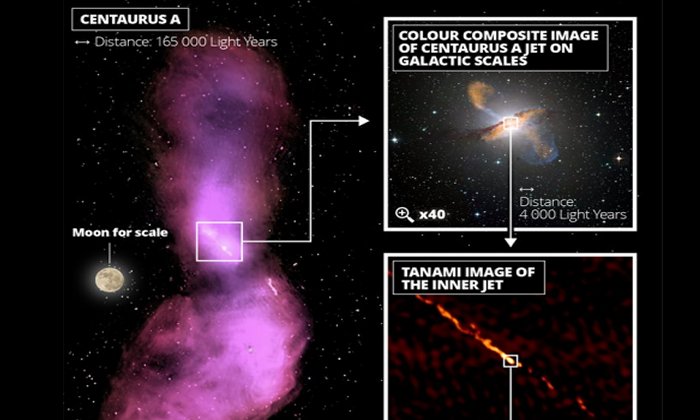Eddie Gonzales Jr. – MessageToEagle.com – An international team anchored by the Event Horizon Telescope (EHT) Collaboration, which is known for capturing the first image of a black hole in the galaxy Messier 87, has now imaged the heart of the nearest radio galaxy Centaurus A in unprecedented detail.
The astronomers pinpoint the location of the central supermassive black hole and reveal how a gigantic jet is being born.
Figure: Distance scales uncovered in the Centaurus A jet. The top left image shows how the jet disperses into gas clouds that emit radio waves. The top right panel displays a color composite image, with a 40⨉ zoom compared to the first panel to match the size of the galaxy itself. The next panel below shows a 165 000⨉ zoom image of the inner radio jet. The bottom panel depicts the new highest resolution image of the jet launching region obtained with the EHT at millimeter wavelengths with a 60 000 000⨉ zoom in telescope resolution. One light year is equal to the distance that light travels within one year: about nine trillion kilometers. Credit: Radboud University; CSIRO/ATNF/I. Feain et al., R. Morganti et al., N. Junkes et al.; ESO/WFI; MPIfR/ESO/APEX/A. Weiß et al.; NASA/CXC/CfA/R. Kraft et al.; TANAMI/C. Müller et al.; EHT/M. Janßen et al.
Most remarkably, only the outer edges of the jets seem to emit radiation, which challenges our theoretical models of jets.
At radio wavelengths, Centaurus A emerges as one of the largest and brightest objects in the night sky. After it was identified as one of the first known extragalactic radio sources in 1949, Centaurus A has been studied extensively across the entire electromagnetic spectrum by a variety of radio, infrared, optical, X-ray, and gamma-ray observatories. At the center of Centaurus A lies a black hole with the mass of 55 million suns, which is right between the masses of the Messier 87 black hole (six and a half billion suns) and Sgr A* in the center of our own galaxy (about four million suns).
EHT observations have been analyzed to image Centaurus A in unprecedented detail.
“This allows us for the first time to see and study an extragalactic radio jet on scales smaller than the distance light travels in one day. We see up close and personally how a monstrously gigantic jet launched by a supermassive black hole is being born”, says MPIfR astronomer Michael Janssen, who recently obtained his PhD at Radboud University.
Compared to all previous high-resolution observations, the jet launched in Centaurus A is imaged at a tenfold higher frequency and sixteen times sharper resolution. With the resolving power of the EHT, we can now link the vast scales of the source, which are as big as 16 times the angular diameter of the Moon on the sky, to their origin near the black hole in a region of merely the width of an apple on the Moon when projected on the sky. That is a magnification factor of one billion.
Supermassive black holes residing in the center of galaxies like Centaurus A are feeding off gas and dust that is attracted by their enormous gravitational pull. This process releases massive amounts of energy and the galaxy is said to become ‘active’. Most matter lying close to the edge of the black hole falls in. However, some of the surrounding particles escape moments before capture and are blown far out into space: Jets – one of the most mysterious and energetic features of galaxies – are born.
Astronomers have relied on different models of how matter behaves near the black hole to better understand this process. But they still do not know exactly how jets are launched from its central region and how they can extend over scales that are larger than their host galaxies without dispersing. The EHT aims to resolve this mystery.
The new image shows that the jet launched by Centaurus A is brighter at the edges compared to the center. This phenomenon is known from other jets, but has never been seen so pronouncedly before.
“We found it challenging to explain with the same models we used for M87. Something different must be happening, like helical magnetic fields, which gives us new clues about how they may ‘squeeze’ the jets” says Sera Markoff, Vice-Chair EHT Science Council and professor for Theoretical High-Energy Astrophysics at the University of Amsterdam.
With the new EHT observations of the Centaurus A jet, the likely location of the black hole has been identified at the launching point of the jets. Based on this location, the researchers predict that future observations at an even shorter wavelength and higher resolution would be able to photograph the central black hole of Centaurus A. This will require the use of space-based satellite observatories.
“These data are from the same observing campaign that delivered the famous image of the black hole in M87. The new results show that the EHT provides a treasure trove of data on the rich variety of black holes and there is still more to come”, says Heino Falcke, EHT board member and professor for Astrophysics at Radboud University.
Written by Eddie Gonzales Jr. MessageToEagle.com Staff








